Volvo’s new XC60 might prove less is more
Filed under: Equinox, Features, Autos
By John Gilbert
BARCELONA, SPAIN
Driving in Spain is a colorful adventure that I had experienced once before, so I felt somewhat familiar during the global auto media’s first opportunity to drive Volvo’s new XC60, the all-new midsize derivative of its superb XC90 SUV.
Volvo stressed the quick and agile handling of the smaller and lighter vehicle with the same powertrain as the larger XC90, which collaborated with Spain’s freeway exits to instantly become more concise than words could describe.
On the North American side of the Atlantic, our freeway exits are usually pretty straightforward — you see the exit and veer onto it, heading for another freeway. In Spain, the freeway system was added to centuries-old cities and rural regions, so it’s a little trickier. Often, you head onto an exit and find it immediately splits right and left. I learned this on my first driving trip to Spain, for the splendid S90 Volvo sedan.
On this trip, our total test drive route was programmed into the navigation setting of our T6 all-wheel drive XC60, so we were informed of upcoming moves by a “Nav Lady,” whom we shall refer to as a “Nav Seniorita” for the sake of geographic accuracy. I drove first, so my co-driver/passenger — a Californian who shall be called “Billy” — could check out the wonderful scenery along and just inland from the Mediterranean without worrying about directions.
Our next exit was to the right and our Nav Seniorita said: “Prepare to keep right and take the next exit, then immediately keep left.” As I pulled into the right lane, she said, “Take the next exit.” Smoothly and at about 80 kilometers per hour I eased off onto the exit. Then with what seemed like urgency the Nav Seniorita said: “Now keep left!”
You don’t want to miss an exit in the Land of Roundabouts, so I abruptly swerved back to the left of the exit barrier, and as the XC60 easily cleared the barrier, but Billy said, “No! Stay right!”
I swerved very abruptly back to the right, still missing the barrier with ease and getting back onto the exit, as the XC60 held its attitude with more poise than its driver, who might have been reflecting the adrenaline rush rising to max. I spotted the split immediately ahead and stayed left, making it smoothly.
I was impressed that I had reacted instantaneously twice, with two very abrupt left-right swerves at highway speed, and more impressed that the XC60 got it right-on, even while our Nav Seniorita was a bit premature with her counter-direction. The vehicle carried out my impulses without any squeals of complaint or any hint of body roll.
Inadvertent or not, it’s always nice to get a real-world example of a vehicle’s features rather than just to accepting marketing claims. We believed them when they talked about the lighter and smaller XC60 having better agility than the XC90, because in totally revising the XC60, Volvo took the XC90’s SPA — Scalable Product Architecture — shortened it, and installed the same high-tech powertrains from the XC90 with all-new suspension stuff. Read more
Ioniq gives Hyundai advanced EV and hybrid
Filed under: Equinox, Autos
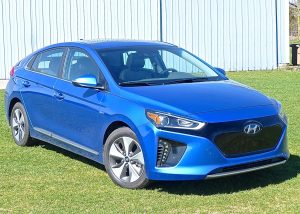
Ioniq offers stylish body on dedicated platform with buyers’ choice of pure electric, hybrid, or plug-in hybrid power.
By John Gilbert
ANN ARBOR, MI.
If the Hyundai Ioniq came out as a stylish new compact car, its sleek and aerodynamic looks, roomy interior, quick and agile performance, and smooth ride would undoubtedly make it a big hit at a base price of $22,200.
But it’s not a mainstream car. Far from it. It has all those above attributes, but it becomes a truly unique vehicle by being offered in a choice of three alternative powertrains. After a brief chance to aggressively road-test two of the Ioniq models, the impression it leaves is — in a word — electrifying.
I asked Hyundai officials if we were all going to be driving electric cars in the near future, or are hybrids a viable alternative. The consensus is that we are headed for electric-powered cars, but it will be a number of years before they take hold, which means hybrids and plug-in hybrids might make the most sense right now. Taking no chances, Hyundai is offering all three alternative powertrains in the new Ioniq.
Apprehensions from preconceived ideas can get in the way of buying a hybrid vehicle, much less a pure-electric one, and while Hyundai officials are aware of all the reasons buyers have for not buying such an alternative-energy car, they have designed the Ioniq to conquer all of them.
The Ioniq is the first car with a dedicated platform — shared with the new Elantra — designed to offer the choice of the most efficient hybrid in the industry, the most progressive plug-in hybrid in the industry, or the most environmentally sound and efficient pure-electric car in the industry.
That’s a lot of firsts, but ever since Hyundai made technical breakthroughs in engine, fuel injection, transmission efficiency, and design development nearly a decade ago, we shouldn’t be surprised by what those creative engineers in Seoul, South Korea, might come up with.
“The best thing is it looks like a regular car, and it drives like a regular car,” said Mike O’Brien, vice president of products for Hyundai Motors America.
I beg to differ. When my driving partner and I took off on the twisty and not always smooth roadways near Ann Arbor, we drove the Ioniqs harder than a normal citizen might drive. We wanted to push the Ioniq to see if it was just another alternative-energy car or truly something special. My vote was the latter.
If I there was a conventional engine under the hood, I would have been impressed that the Ioniq swept around tight, even blind, curves, always with the car following dutifully and with precision to all steering inputs. The fact that it was pure electric made it all the more impressive when it stayed level, never lurched, and handled the numerous road irregularities we flew across with nary a hint of harshness, looking high-style from every angle.
When my turn was finished, I found the passenger bucket seat supportive and comfortable in all circumstances, and it gave me a better chance to admire the smooth and high-end look and feel to the seats, dashboard and numerous features. They use wood chips and bits of volcanic rock to make the soft and supple top on the dashboard, for example. And they found a way to mix soybean oil into the paint, as another example of making the car sustainable.
The basic Ioniq Hybrid starts at a mere $23,000 including destination, its 1.6 engine helping recharge the battery pack. The plug-in Hybrid next up the scale, while the top-end, pure-electric version starts at $29,500. The EV will have no gas-engine safety net, but it will have a range of 124 miles before needing a recharge. It has a larger electric motor system, and a potent version of the LG Chem battery pack that develops 88 kW, the equivalent of 118 horsepower and 218 foot-pounds of torque, which collaborate to send the car rocketing away from a stop with startling potency.
There are other dazzling EVs newly on the market, such as the Tesla, the Chevrolet Bolt, Nissan Leaf, and BMW i3. The Bolt has a range of 238 miles, which is very impressive, and the Tesla also has excellent range. O’Brien, however, referred to industry standards for thermal efficiency, which take into account such things as the carbon footprint. Since 67 percent of our electric energy comes from fossil fuel or coal, the reality is that electric power may seem free, but nothing is free.
“Ultimately, we’re going to have to reduce our carbon footprint,” O’Brien said. “They call it an ‘MPGe’ equivalent, and by that calculation the Ioniq is the most efficient EV with a 136 MPGe, which beats the i3, the Bolt, and all other EVs on the market.”
O’Brien explained the assets of the three-pronged answer to all the alternative-energy challenges by first enumerating the challenges.
“While hybrid and electric vehicles have been around for awhile, it’s still a fact that 97 percent of buyers have not bought them,” said O’Brien. “That means only 3 percent are choosing hybrids or electric vehicles. We seem to be stuck on that number. The reasons consumers give for avoiding hybrids are: cost, lack of performance, boring, maintenance worries, not sporty enough, and insufficient passenger or cargo room.
“When you look under the hood of a Camry or Accord hybrid, you see all kinds of extra space, because the platform was designed for a larger engine. With a dedicated platform, and using a small engine with the hybrid, means we didn’t need all that space. So we moved the cowl forward, reducing the size of the engine compartment, and creating a much more spacious interior. Our hybrid has a total interior volume of 122.7 cubic feet, and our plug-in hybrid and EV have 120 cubic feet.”
In addition, Hyundai worked with LG Chem, the South Korean electronics giant that designed and built the battery pack for the Chevrolet Volt, and the new Chevrolet Bolt pure-electric, as well as for Hyundai, Kia and other hybrid car-makers. The streamlined design of the battery pack, with vertical plates, and a lithium ion polymer structure, make it lighter and smaller and able to be form-fit into odd areas. And lithium-ion-polymer battery packs generate more power, hold the charge longer, and recharge more quickly.
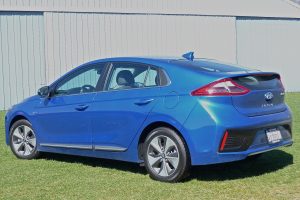
Battery pack location under rear seat provides mid-car weight balance, full 122.7 cubic feet of cargo space.
Other hybrid car-makers fit the battery pack under the trunk, which greatly cuts down the cargo room, and, being heavy, gives most hybrids an odd weight-distribution. Hyundai engineers designed the Ioniq with the battery pack under the rear seat, leaving full trunk space, and creating a lower center of gravity and a mid-engine feel that enhances steering and contributes to good handling.
Hyundai engineers also revised their well-proven 1.6-liter Kappa 4-cylinder, a dual-overhead-camshaft gem with direct injection that can make compact cars, midsize cars, and even the Tucson compact SUV perform admirably, with a turbocharger in some cases. In the Ioniq, it is altered with Atkinson-cycle technology that keeps the intake valves closed a bit longer, and delays the opening of the exhaust valves. That allows the air-fuel mixture more time to more fully ignite, resulting in greater thermal efficiency, and extra power. With the hybrid, the engine doesn’t need extra power, because the electric motor supplements any need for power.
In the Ioniq Hybrid, the 1.6 has 104 horsepower at a high 5,700 RPMs, and 109 foot-pounds of torque at 4,000 RPMs. The electric motor adds 32 kW (43 horsepower) for a 125 horsepower maximum, and its 125 maximum added torque combines for a 139 foot-pound punch.
The biggest surprise to many traditionalists is that electric motor power is more efficient than a gas engine. It has 100 percent of its torque at zero RPMs, so stepping hard on an electric car’s “gas” pedal can snap your head back by surprise. In the Ioniq Hybrid, the electric motor’s instant torque aids low-end power, and if you need extra power at high speed, the electric power can continue to supplement the 4-cylinder up to 75 miles per hour.
After being thoroughly impressed with the pure-electric Ioniq, we also drove the base-model hybrid, which also drove well, with quick acceleration, and good steering and handling. Unlike nearly all other hybrids, the Ioniq Hybrid does not use a CVT, the continuously variable transmission that uses belts and pulleys to seamlessly shift, but leaves the unsatisfying feeling of “motorboating” instead of tangible shift points.
Hyundai engineers equipped the Ioniq with their own 6-speed dual-clutch transmission that shifts swiftly and with a decisive sportiness, whether you like paddles or just switching to “sport” to hold shift points higher. The “eco” setting upshifts earlier for better economy, and the Ioniq Hybrid comes away with everyday fuel economy of 59 highway, and 58 mpg combined city-highway. That beats the Prius and all other hybrids, as does the Ioniq’s thermal efficiency that means 40 percent of all its energy goes to its wheels, which are shod with specially designed Michelin tires.
We didn’t get to drive the plug-in hybrid, which is yet to be introduced as the third electrified system. That will move up from the Hybrid’s 32 kWh with 43 horsepower, to 45 kWh, and 60 horsepower. With more electric motor power in the mix, when fully charged it will go 27 miles on electric only, before the gas engine kicks in seamlessly to help.
Both hybrids share the 6-speed dual-clutch transmission. The plug-in Hybrid has a more powerful charger. You can connect to normal household outlets, but if you use the quick-charge system you can recover 80 percent of a full charge in 23 minutes, a fast charge that will let you cover another 99 miles.
All available safety items, including standard rear camera, and the availability of lane-change devices, are included, and the Ioniq also has all the latest in connectivity features.
I am eager for a longer test-drive, but the first impression will be hard to shake. The Ioniq beats the tests of cost, sportiness, being not boring, being not sporty, and having insufficient interior room.
If maintenance worries still exist as the last concern, how about this: Along with Hyundai’s usual 10-year, 100,000-mile engine warranty, there is a lifetime warranty on the battery pack.
I kidded O’Brien that if the Ioniq doesn’t quite meet fuel-efficiency figures, they could come out with a Type R and insert a tiny “R” between the “I” and the “O” to make it an “Ironiq.” He didn’t laugh. After driving the car, I’m more inclined to suggest they might need to insert a small “C,” because the new car could indeed become Iconiq.
Atlas more than a shrug as VW’s large SUV
Filed under: Equinox, Autos
By John Gilbert
BOERNE, Texas
Volkswagen needed a large SUV much more than the marketplace needed another large SUV, and that in essence, is why the Atlas came to be designed and built as an American demands.
If you were a fan of reading Ayn Rand, you could say that VW officials in Wolfsburg, Germany, decided, “We must have a larger SUV,” and Atlas Shrugged. Sorry about that.
The point is that if a consumer family loved its succession of Volkswagen vehicles, but grew past the point where everybody could fit inside a Golf, or a Jetta, or even a Tiguan or Touareg — which will seat four comfortably and five in a squeeze — then they would have to go off and buy a Tahoe, Explorer, Honda Pilot, any of several Toyotas, or any of a couple dozen other alternatives.
Thus it made sense that as a family outgrew its VW, the Atlas would give those customers a larger VW SUV to grow into. It has three rows of seats, foldable into various configurations depending on whether you need to haul people or luggage, or major pieces of equipment.
The Atlas is the largest vehicle Volkswagen has made, and it will be built in the new Chattanooga, Tenn., plant VW built for Passat sedans. But for the first media drives, Volkswagen decided to corral us in San Antonio, from where we were driven northward to the small town of Boerne, Texas, and stationed at the Tapatio Springs Hill Country Resort.
It is a fantastic facility, with an 18-hole golf course, and enough space to hold various presentation meetings, as well as a full-scale Texas barbeque. (I like barbequed brisket, but I don’t bother with it when there are also ribs available; there were ribs available at our patio dinner, cooked as perfectly as you could want.)
After we looked over the large exterior of the Atlas, senior product manager Mark Gillies began his presentation by explaining why the company picked the vast expanse of Texas for the intro drive. “The Atlas is big, and it looks right at home with all the big SUVs down here,” he said. Other officials added that it is designed, tailored and built in the U.S. “to fit American families.”
The Atlas looks the part, but the secret of success in that hotly competitive segment is how the vehicle feels, how it drives, and how flexible its game plan is executed. The Atlas is built on VW’s MQB platform, which is versatility personified. The entire Golf family, Jetta, Passat and Tiguan all share versions of that underpinning. Read more
Challenger GT adds AWD for winter muscle
Filed under: Equinox, Autos
By John Gilbert
PORTLAND, Maine — Driving a powerful muscle car on a curving icy roadway can become a sudden thrill when it breaks traction and starts skidding as if it intends to broadslide into the snowbank on the right shoulder.
“Oops!” just doesn’t quite cover it.
But the instincts gained while driving up and down the hills od Duluth, Minnesota, paid rich dividends. I didn’t yank the steering wheel into the direction of the skid, and I didn’t abruptly hit the brakes. Instead, I eased off the gas slightly while steering in an attitude that let the vehicle’s traction-control straighten us out and continue on our intended path as I eased back into the middle of our lane.
“Good job,” said my co-driver, who had good reason to be less poised than I was as we sailed through the woods just outside Portland, Maine. We were cheating, though, because the red Challenger we were in was a pre-production GT model with all-wheel drive.
It’s not as though we don’t get enough winter weather in Northern Minnesota, but there was no way to pass up this opportunity. Dodge invited a group of auto journalists to visit the rock-bound coast of Maine at the end of January for the first chance to drive the new Challenger GT, which, for 2017, can be bought with all-wheel drive. As such, I felt obligated to push it toward its limits.
The Challenger is a vehicle that is always fun to drive, joining the Ford Mustang and Chevrolet Camaro among the three “ponycar” throwbacks — I call them “future retro” — because they recreate the Trans-Am road-racing heyday of the late 1960s and early 1970s in North America. Dodge calls them “Muscle Coupes,” which is OK, too.
The three were ferocious rivals in road-racing, and among the joys of my sports and auto writing career was to be able to cover that Trans-Am series at places such as Donnybrooke Speedway (now BIR, for Brainerd International Raceway), Elkhart Lake, Bridgehampton and all points where road-racing circuits existed. They were a diversion from the hot-rod sedans of the late 1960s and the spider-like open-wheeled formula cars, with 2 doors and a specific silhouette of long-hood, short rear deck.
The Mustang continued on while the Camaro and Challenger were discontinued along with the Pontiac Trans-Am, Plymouth Barracuda, American Motors Javelin and a few others. But about the time Ford decided to redo the Mustang in a style that recaptured the attitude and demeanor of the 1970 model, Camaro came back out and did the same thing, and so did Challenger.
Dodge’s great-looking Challenger was created by dropping the coupe body on the platform for the larger Charger 4-door sedan, and the shortcut produced a very competitive vehicle. In some ways, it has an edge.
Some say the Challenger looks most like the 1970 car, but in any event it has a larger trunk and a more spacious interior, which can actually house a couple of adults in something approaching comfort. But in all cases, the Challenger, Mustang and Camaro are summertime cars, with front-engine, rear-drive that makes for enormous fun in the summer, spring and fall, but virtually need to be parked in the winter if you live in snowy weather. No traction control system can conquer the glare ice of winter with a rear-driver.
The Dodge Charger added a model a few years ago with an all-wheel-drive system underneath. While the arsenal of Hemi V8s make both the Charger and Challenger fly, the very strong 3.6-liter Pentastar V6 is more than capable in the Charger and Challenger, and works well enough in the AWD version of the Charger that many police departments deploy it to chase — and catch — the bad guys in bad weather.
We should have anticipated this move, then. Dodge has refined that all-wheel-drive system for the smaller Challenger coupe. “We were able to take the all-wheel-drive system from the Charger and use it in the Challenger,” said chief engineer Allison Rahm. “It’s not exactly the same, because we had to refine it in a few ways. We took the Charger Pursuit sedan, used by some police departments, and adapted the suspension, stabilizer bars, springs and steering calibration, and gave it its own vehicle dynamic control that uses the same front-axle disconnect.
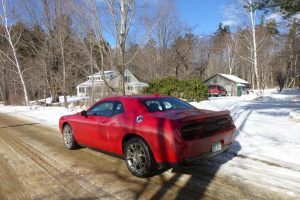
Instead of being skittish, and skiddish, the Challenger GT has newfound stability, even on icy rural roads of Maine..
“We have developed the perspective on a test area we use in Northern Michigan, where they have huge snow-pack fields. We learned we can push the car and stay in control, so it’s fun, cool, and you can drive it very confidently. It goes back to rear-wheel drive when you don’t need it, but in snowy conditions, or when it senses wheelspin, its sensors can send up to 100 percent of the torque to the front.”
How the car is being driven also activates AWD, and the unit only adds 200 pounds to the overall weight of the Challenger, which sits low and doesn’t betray the fact that all four wheels can pull the car.
Ben Lyon showed us an interesting map of the U.S. with a horizontal line across the middle, from northern California to the East Coast. Market research indicates all-wheel-drive models of the Charger and such SUVs as the Durango are up 12 percent year-over-year in sales from last year. On the Charger, AWD makes up 17 percent of purchases altogether, and in the 17 states north of that horizontal line across the nation, the take rate is over 50 percent all-wheel drive on vehicle purchases.
“We also surveyed buyers who looked at the Challenger but didn’t buy,” said Lyon, the Challenger brand manager. “One-third said all-wheel drive was important, and when they stopped considering the Challenger, half of them then bought something with all-wheel drive.”
We had our choice of colors and I took red, instead of orange. Both were stunning. Powering the Challenger is that Pentastar V6, a 3.6-liter unit with 305 horsepower at 6,350 RPMs, and 268 foot-pounds of torque at 4,800 RPMs. More than 90 percent of the peak torque is provided from 1,800 to 6,400 revs which gives you pretty constant power anywhere in the tach’s range.
The only thing that rivals that power is the audio system, which barks through a 506-watt amplifier. A surprisingly large trunk and fold-down rear seat allow you to haul long things, even skis. Specific GT leather bucket seats and trim on the dash and console set the car apart as well.
Naturally, all the goodies boost the price. Our test car started at $33,395 and as-tested it was $40,555.
Stability control and all the assumed connectivity features of Apple CarPlay and Android Auto can be brought to life. Also, the performance information from the Hellcat Trac Pak with readouts on the 8.4-inch center screen let you monitor 0-60 times, G-forces and a launch-control device.
For driving performance, the power is harnessed by the 8-speed automatic with paddle shifters, and if you switch into Sport mode, or drive aggressively, you are immediately in all-wheel drive. Otherwise, your driving style will summon AWD instantly and seamlessly by assessing road conditions.
We found driving the Challenger GT smooth and precise, with the possible exception of my little unscheduled side-skid that threatened the shoulder. So we were ready for the test track, even as the temperature climbed to a less-than-challenging 45 degrees. We would have prefered the harshness of the “Nor’easter” that hit the area one day earlier.
I had the chance to be first out on the well-groomed test track at a road-racing course Dodge had contracted, with a circular stability track, a straight line acceleration stretch, and a small autocross-like circuit that could challenge us for our driving response and the car’s capability.
The stylish 19-inch wheels were shod with some high-performance all-season Michelin tires, and they proved pretty good — but not exceptional to a winter-driving veteran. Michelin might be the best at building tires for long wear and high speed, but to do that, the tread compound is firm enough that it becomes hard — and slick — in severe cold. Such as winter.
The production Michelins worked well to test the car around the circular skid course, where you could jockey the car back and forth and even provoke a bit of skidding, just for fun. After several laps around that, in 6-inch deep snow, we moved over to the auto-cross like course.
The groomer had done a great job smoothing out the trail, and my instructor informed me that I could be confident staying on the power if we got off into the deeper snow. I got off a little, putting the left-side tires into the fringe area, and when I stayed on the power, it went a bit farther off, until it got hung up.
I know enough to stay on the power in moderate snow, and I did that, right until it hung itself up, What fooled us was that the groomer had groomed a bit wider than the outer groove, so when I thought I was still on the track, the left side tires already were off the surface. No problem. Four guys tried to push me out, but we had to summon the groomer, which hooked up to the rear and pulled us out of the snow.
That may have helped set the stage for the rest of . I suggested to Ms. Rahm, the chief engineer, that the Michelins were probably excellent for 90 percent of the all-weather driving Dodge might anticipate for the car’s use, but I would suggest a set of Nokian all-season or snow tires.
I’m guessing that won’t happen, because no automaker builds a car with tires aimed specifically at snow-country. And that’s OK. All-wheel drive already gives the Challenger GT AWD a large jump on Mustangs and Camaros — and virtually all other muscle cars — on snow and ice. With the right winter tires, it could could make hardy drivers park their SUVs.
Auto Show season 2017 stirs up new Buzz
Filed under: Equinox, Features, Autos
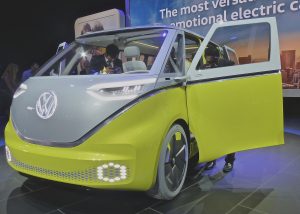
Nobody says it’s a new Microbus, but VW’s concept I.D. Buzz has the shape, with electric power and autonomous drive.
By John Gilbert
DETROIT, MI. — Self-driving vehicles, continued electrification of our global driving future, and an endless stream of sport-utility vehicles of all shapes and sizes are the indelible story of the 2017 North American International Auto Show, which consumed early January, 2017.
High-performcance and luxury vehicles were present also, of course, but nearly all manufacturers were either proclaiming or hinting about electric or autonomous (self-driving) cars.
Those of us who love to drive, to push a car to its limits with skill and dexterity — both yours and your car’s — may recoil at the thought of computer gremlins taking over the operation of our future cars, but that’s where we’re headed and everybody wants to be leading the pack.
For that reason, a highlight of the Detroit show for me was the showing of the I.D. Buzz. Strange name indeed, but it’s just the nickname of a Volkswagen concept vehicle that could well be the long-awaited emergence of the modernized Microbus, that hippie-happy minivan of the 1960s.
The Buzz is an eye-catcher, to be sure, and it’s obviously a concept vehicle because it’s hard to imagine it coming to life in production. But it ties together all of the ingredients for success on the auto show circuit of 2017 — an inventive and retro-flair people-hauler with an interior that could pass as a high-tech den, plus all-electric power with a range of 270 miles on a charge, and autonomous operation.


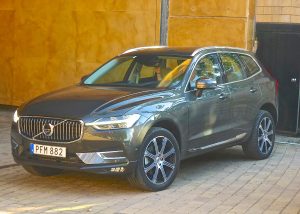
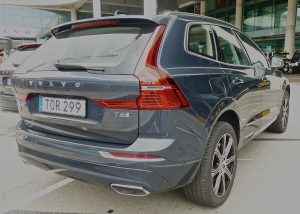
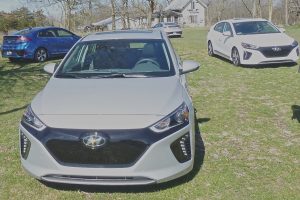
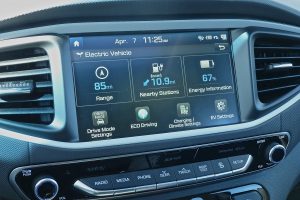
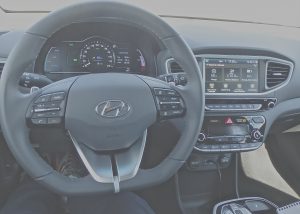
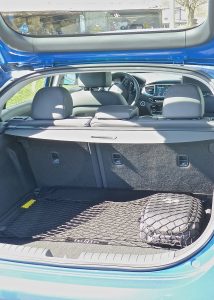
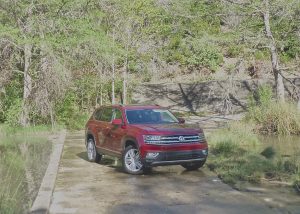
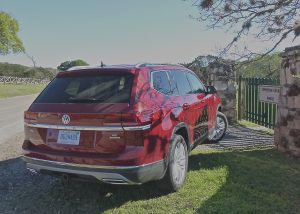
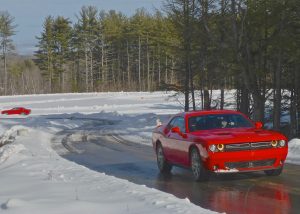
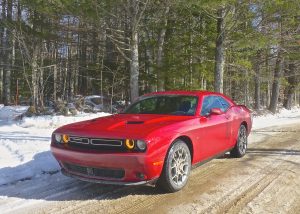
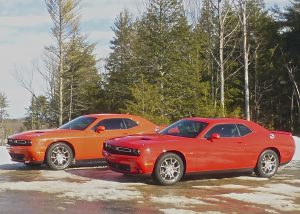
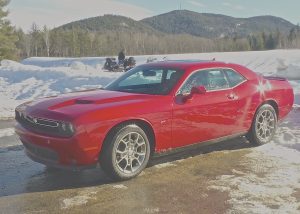
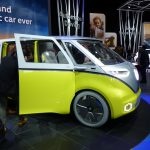

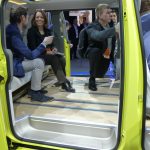
 John Gilbert is a lifetime Minnesotan and career journalist, specializing in cars and sports during and since spending 30 years at the Minneapolis Tribune, now the Star Tribune. More recently, he has continued translating the high-tech world of autos and sharing his passionate insights as a freelance writer/photographer/broadcaster. A member of the prestigious North American Car and Truck of the Year jury since 1993. John can be heard Monday-Friday from 9-11am on 610 KDAL(www.kdal610.com) on the "John Gilbert Show," and writes a column in the Duluth Reader.
John Gilbert is a lifetime Minnesotan and career journalist, specializing in cars and sports during and since spending 30 years at the Minneapolis Tribune, now the Star Tribune. More recently, he has continued translating the high-tech world of autos and sharing his passionate insights as a freelance writer/photographer/broadcaster. A member of the prestigious North American Car and Truck of the Year jury since 1993. John can be heard Monday-Friday from 9-11am on 610 KDAL(www.kdal610.com) on the "John Gilbert Show," and writes a column in the Duluth Reader.